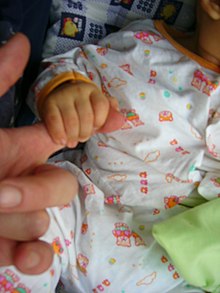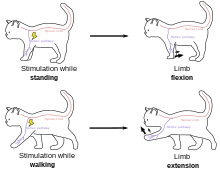A reflex, or reflex action, is an involuntary and nearly instantaneous movement in response to a stimulus.[1][2] A reflex is made possible by neural pathways called reflex arcs which can act on an impulse before that impulse reaches the brain. The reflex is then an automatic response to a stimulus that does not receive or need conscious thought.[3]
Types of human reflexes
Myotatic reflexes
The myotatic reflexes (also known as deep tendon reflexes) provide information on the integrity of the central nervous system and peripheral nervous system. Generally, decreased reflexes indicate a peripheral problem, and lively or exaggerated reflexes a central one. A stretch reflex is the contraction of a muscle in response to its lengthwise stretch.
- Biceps reflex (C5, C6)
- Brachioradialis reflex (C5, C6, C7)
- Extensor digitorum reflex (C6, C7)
- Triceps reflex (C6, C7, C8)
- Patellar reflex or knee-jerk reflex (L2, L3, L4)
- Ankle jerk reflex (Achilles reflex) (S1, S2)
While the reflexes above are stimulated mechanically, the term H-reflex refers to the analogous reflex stimulated electrically, and tonic vibration reflex for those stimulated to vibration.
Tendon reflex A tendon reflex is the contraction of a muscle in response to striking its tendon. The Golgi tendon reflex is the inverse of a stretch reflex.
Reflexes involving cranial nerves
Reflexes usually only observed in human infants

Newborn babies have a number of other reflexes which are not seen in adults, referred to as primitive reflexes. These automatic reactions to stimuli enable infants to respond to the environment before any learning has taken place. They include:
- Asymmetrical tonic neck reflex (ATNR)
- Palmomental reflex
- Moro reflex, also known as the startle reflex
- Palmar grasp reflex
- Rooting reflex
- Sucking reflex
- Symmetrical tonic neck reflex (STNR)
- Tonic labyrinthine reflex (TLR)
Other kinds of reflexes
Other reflexes found in the central nervous system include:
- Abdominal reflexes (T6-L1)
- Gastrocolic reflex
- Anocutaneous reflex (S2-S4)
- Baroreflex
- Cough reflex
- Cremasteric reflex (L1-L2)
- Diving reflex
- Muscular defense
- Photic sneeze reflex
- Scratch reflex
- Sneeze
- Startle reflex
- Withdrawal reflex
- Crossed extensor reflex
Many of these reflexes are quite complex requiring a number of synapses in a number of different nuclei in the CNS (e.g., the escape reflex). Others of these involve just a couple of synapses to function (e.g., the withdrawal reflex). Processes such as breathing, digestion, and the maintenance of the heartbeat can also be regarded as reflex actions, according to some definitions of the term.
Grading
In medicine, reflexes are often used to assess the health of the nervous system. Doctors will typically grade the activity of a reflex on a scale from 0 to 4. While 2+ is considered normal, some healthy individuals are hypo-reflexive and register all reflexes at 1+, while others are hyper-reflexive and register all reflexes at 3+.
Reflex modulation

Naively, we might imagine that reflexes are immutable. In reality, however, most reflexes are flexible and can be substantially modified to match the requirements of the behavior in both vertebrates and invertebrates.[4][5][6]
A good example of reflex modulation is the stretch reflex.[7][8][9][10] When a muscle is stretched at rest, the stretch reflex leads to contraction of the muscle, thereby opposing stretch (resistance reflex). This helps to stabilize posture. During voluntary movements, however, the intensity (gain) of the reflex is reduced or its sign is even reversed. This prevents resistance reflexes from impeding movements.
The underlying sites and mechanisms of reflex modulation are not fully understood. There is evidence that the output of sensory neurons is directly modulated during behavior—for example, through presynaptic inhibition.[11][12] The effect of sensory input upon motor neurons is also influenced by interneurons in the spinal cord or ventral nerve cord[10] and by descending signals from the brain.
| This article uses material from the Wikipedia article Metasyntactic variable, which is released under the Creative Commons Attribution-ShareAlike 3.0 Unported License. |